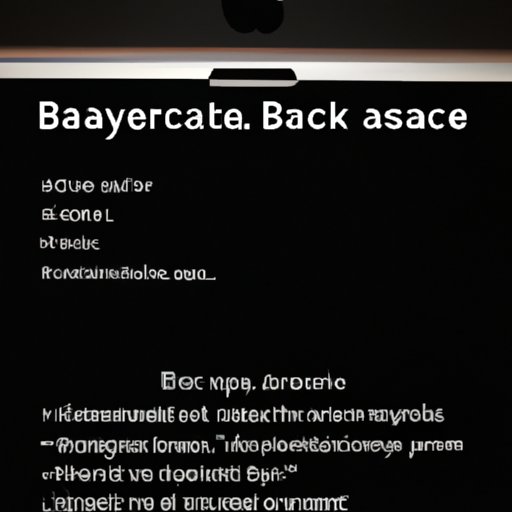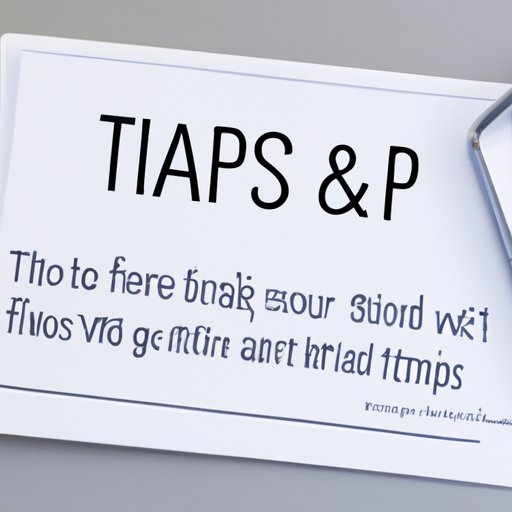
Introduction
Whether you’re a blogger, designer, or just a MacBook Air user, taking screenshots is an easy and essential task that lets you capture and share information quickly. You can take screenshots of web pages, software interfaces, and anything else that’s displayed on your screen, making it easier to share information with others. If you’re new to the MacBook Air, you might be wondering how to take screenshots. That’s why we’ve created this guide to help you out. In this article, we’ll cover everything you need to know about taking screenshots on a MacBook Air.
Step-by-Step Guide to Taking Screenshots on a MacBook Air
Let’s start with the basics. Here’s how to take a screenshot on a MacBook Air:
A. How to capture the entire screen
If you want to capture everything that’s displayed on your screen, you can use the following keyboard shortcut:
Command + Shift + 3
Once you press these keys, your screen will flash, indicating that a screenshot has been taken. The screenshot will be saved to your desktop by default.
B. How to capture a specific area
Sometimes, you might only want to capture a specific area of your screen. You can use the following keyboard shortcut to do this:
Command + Shift + 4
1. How to select the specific area
Once you press this keyboard shortcut, your cursor will change to a crosshair. You can click and drag your mouse to select the area that you want to capture. To exit without taking a screenshot, press the Esc key.
2. How to adjust the screenshot if you need to
If you’ve selected the wrong area or need to make adjustments to the screenshot, you can press and hold the spacebar key. This will let you move the selection box around the screen. You can also adjust the selection by using the arrow keys.
C. Additional options for screenshots
There are a few additional options you can use when taking screenshots:
Command + Shift + 5: This brings up the screenshot toolbar, which lets you take screenshots or record a video of your screen.Control: This lets you take a screenshot of the Touch Bar.Shift: This lets you take a screenshot and save it to your clipboard instead of your desktop.
Explaining Keyboard Shortcuts for taking Screenshots
If you take a lot of screenshots, using keyboard shortcuts can save you time and make the process more efficient. Here’s how to use keyboard shortcuts for screenshots:
A. How to use the keyboard to take a screenshot
We’ve already covered the basic keyboard shortcuts for taking screenshots on a MacBook Air. You can also customize your keyboard shortcuts by going to System Preferences > Keyboard > Shortcuts > Screenshots.
B. Explanation of how the keyboard shortcuts work
The keyboard shortcuts work by triggering macOS to take a screenshot. When you press the keyboard shortcut, macOS creates an image file of your screen or selection and saves it to your desktop.
C. Benefits of using keyboard shortcuts
Using keyboard shortcuts for screenshots is more efficient than using the mouse. You can take screenshots quickly and easily without having to open an application or use the mouse. This can save you a lot of time if you’re taking a lot of screenshots.
Comparison of Different Screenshot Tools Available for Mac
While macOS comes with a built-in screenshot tool, there are also third-party tools available that offer more features and functionality. Let’s compare the pros and cons of different screenshot tools:
A. Built-in MacOS Screenshot Tool
1. Overview of features
The built-in macOS screenshot tool offers the following features:
- Can capture the entire screen or a specific area
- Can save to the desktop or clipboard
- Offers a few additional options, such as a timer and Touch Bar screenshots
2. Pros and Cons
Here are the pros and cons of using the built-in macOS screenshot tool:
- Pros:
- Free and easy to use
- Comes pre-installed on your MacBook Air
- Offers enough features for most users
- Cons:
- Doesn’t offer advanced editing or annotation features
- Can’t take scrolling screenshots
- Doesn’t offer cloud syncing
B. Third-Party Options (Snagit or Skitch)
1. Overview of features
Third-party screenshot tools offer a number of additional features that the built-in macOS tool lacks. Here are some of the features offered by Snagit and Skitch:
- Advanced editing and annotation features
- Can take scrolling screenshots
- Offers cloud syncing and sharing options
- Can record videos of your screen
2. Pros and Cons
Here are the pros and cons of using third-party screenshot tools:
- Pros:
- Offers advanced editing and annotation features
- Can take scrolling screenshots
- Offers cloud syncing and sharing options
- Can record videos of your screen
- Cons:
- Costs money
- Learning curve for using new software
- May be more complex than necessary for some users
C. How to choose the right tool for your needs
The right screenshot tool for you will depend on your needs. If you’re a casual user who just needs to take occasional screenshots, the built-in macOS tool will be sufficient. If you need more advanced features and editing options, a third-party tool like Snagit or Skitch might be a better fit.
Tutorial on Editing and Annotating Screenshots Using the Preview App
After taking a screenshot, you might need to edit or annotate it. The Preview app on macOS offers a number of editing and annotation features. Here’s how to use Preview to edit your screenshots:
A. How to use the Preview app to edit images
After taking a screenshot, the image will automatically open in Preview. Here’s how to edit your screenshot:
- To crop the image, select the area you want to keep and go to
Tools>Crop. - To resize the image, go to
Tools>Adjust Sizeand enter the new dimensions. - To adjust the color or exposure, go to
Tools>Adjust ColororAdjust Exposure.
B. Different ways to annotate screenshots
Preview also offers a number of annotation features, such as adding text, arrows, and shapes to your screenshot:
- To add text, go to
Tools>Annotate>Text. - To add shapes, go to
Tools>Annotate>Shapes. - To add arrows, go to
Tools>Annotate>Speech Bubble, then click and drag the handle to turn it into an arrow.
C. How to save your edited screenshot
After editing your screenshot, make sure to save your changes by going to File > Save or Export.
Troubleshooting Common Issues with Screenshotting on MacBook Air
While taking screenshots is generally a straightforward task, sometimes you might encounter issues. Here are some common issues and solutions:
A. Issues with file format
If your screenshots are saved in a file format that’s not compatible with your needs, you can change the file format by going to System Preferences > Keyboard > Shortcuts > Screenshots. You can also change the default file format by going to Terminal and running the following command:
defaults write com.apple.screencapture type [file format]
B. Issues with file location
If your screenshots aren’t being saved to your desktop, you can change the default location by going to Terminal and running the following command:
defaults write com.apple.screencapture location [file path]
Make sure to replace [file path] with the file path where you want to save your screenshots.
Best Practices for Using Screenshots in Professional Contexts
If you’re using screenshots in a professional context, it’s important to use them appropriately and effectively. Here are some best practices:
A. Explaining when and where to use screenshots
You should use screenshots whenever you need to explain a process or demonstrate something to someone. You can use screenshots in blog posts, presentations, and support requests.
B. Tips on taking effective screenshots
Here are some tips for taking effective screenshots:
- Make sure your screenshot is clear and easy to understand
- Include annotations and arrows if necessary to highlight important information
- Try to keep the file size small without sacrificing clarity
C. Examples of how to use screenshots in professional contexts
You can use screenshots in a variety of professional contexts, such as:
- Support requests: Include a screenshot to help the support team understand the issue you’re facing
- Blog posts: Use screenshots to illustrate your points and make your content more engaging
- Presentations: Include screenshots to help your audience understand your message more clearly

Tips and Tricks for Using Screenshots More Effectively
Here are some additional tips and tricks for using screenshots more effectively:
A. Adding Screenshots to Emails for Support Requests
If you’re sending a support request via email, it can be helpful to include a screenshot to help the support team understand the issue. To do this, simply drag and drop the screenshot into your email message.
B. Creating GIFs from Screenshots
You can also use screenshots to create GIFs. To do this, you’ll need to use a third-party tool like LiceCap or GIPHY Capture.
C. Other ways to Use Screenshots Effectively
You can also use screenshots for:
- Creating tutorials
- Capturing error messages
- Documenting software interfaces
- Creating visual aids for presentations
Conclusion
Congratulations! You’ve completed our guide to taking screenshots on a MacBook Air.





